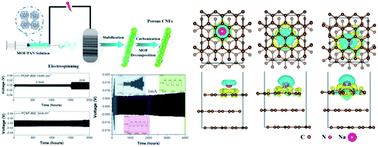Metal–organic framework-induced mesoporous carbon nanofibers as an ultrastable Na metal anode host†
Abstract
Defect-engineered, porous carbon nanofibers (PCNFs) are electrospun as a sodiophilic host for sodium/carbon (Na/C) composite anodes for Na metal batteries. Abundant mesopores are introduced by decomposition of bimetallic metal–organic framework (MOF) nanopowders during carbonization, which create uniformly distributed active sites for Na nucleation to allow facile electrolyte access to the entire electrode. The nitrogen and oxygen functional groups on the fiber surface reduce the Na adsorption energy barrier, ameliorating the nucleation and deposition of Na, as corroborated by density functional theory (DFT) calculations. The anode is cycled for over 4000 h at 1 mA cm−2 and over 2000 h at a higher current density of 3 mA cm−2 with stable voltage profiles and extremely low hysteresis owing to full utilization of the carbon matrix. Furthermore, the Na–C/Na3V2(PO4)3 (NVP) full cell endures 1000 cycles with coulombic efficiencies greater than 98%. The findings arising from the defect-engineered CNFs may offer new insight into designing dendrite-free Na metal anodes by tailoring porosity and surface functionality of carbon host materials.



 Please wait while we load your content...
Please wait while we load your content...